HeadedToTexas
Guru
See attachment below[/ATTACH]
Nice set up, Dave. Why the whipping on the sides of the larger eye?
See attachment below[/ATTACH]
Just a simple chain hook like you'd find on trucks' chain binders works great. Simple, cheap and available in stainless steel.
A follow up to the bridle thread. But, I’d like to know your fav chain hook. This will be used with a V bridle, which is 2x 3/4” 3strand currently. On a cat, so well beyond the early decisions of whether or not to use a bridle.
The PO had rigged a stainless snap latch that fits inside and between links. Nooo.
data:image/jpeg;base64,/9j…..[/QUOT
I use a Mantus bridle, Mantus chain hook on a snubber and a Mantus swivel on my Mantus anchor. I have almost no hunting, there is no anchor chain grinding on the bow pulpit channel and roller and all stress is removed from the windless. I highly recommend this setup.
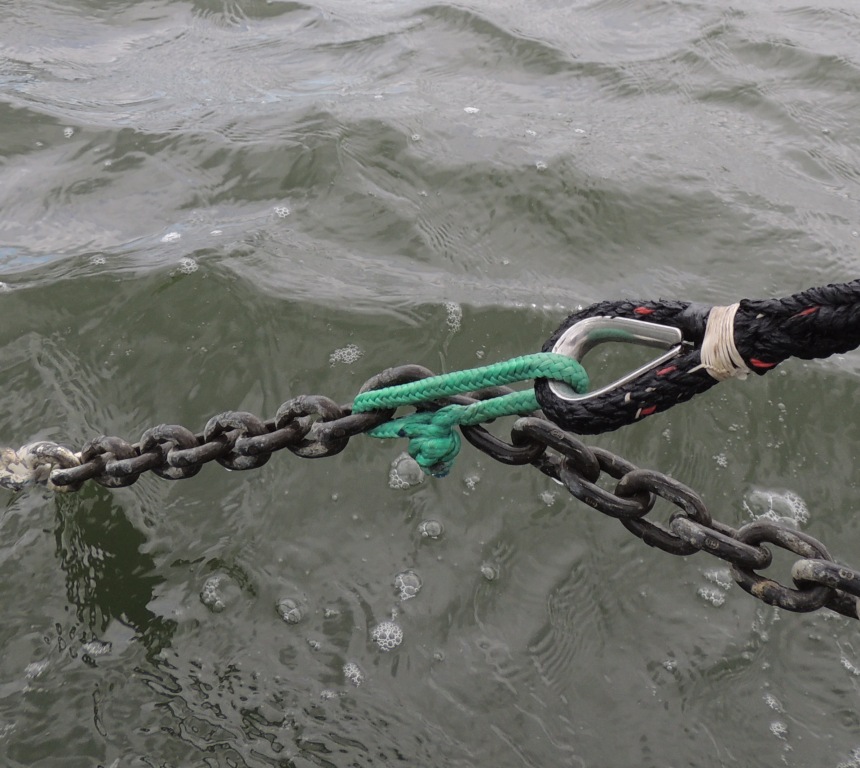
NopeTwisted,
Does that "shackle" ever come off (fall off) if the whole system goes slack, as in dead calm conditions? I have never used that type, nor seen it first hand.
Nice set up, Dave. Why the whipping on the sides of the larger eye?
Twisted,
Does that "shackle" ever come off (fall off) if the whole system goes slack, as in dead calm conditions? I have never used that type, nor seen it first hand.
I use a two leg bridle with a nylon eye spliced into the end of each. I use a dynema piece that have a loop on one end that attaches I both eyes with a larks head and has a shackle loop on the other end. I have a dynema loop that has a stopper knot on it that is wrapped around the chain much like that pendant is. Then the stopper knot is put in the shackle loop.
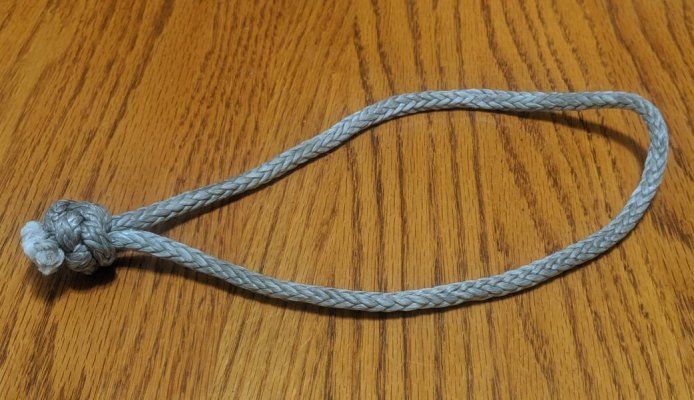
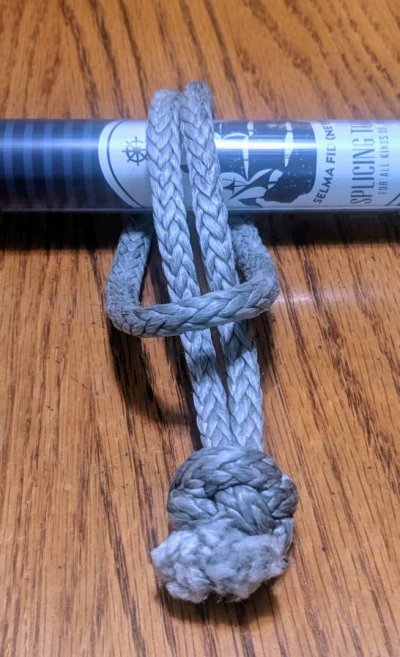

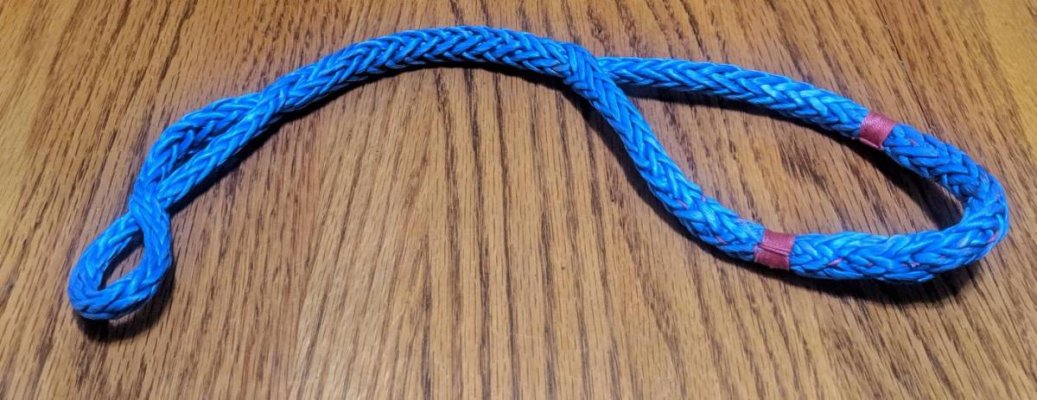
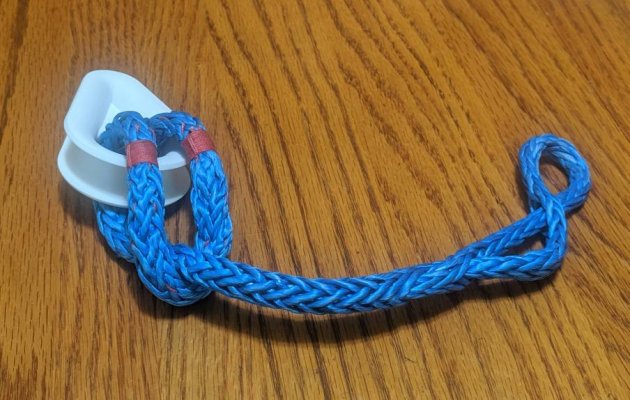
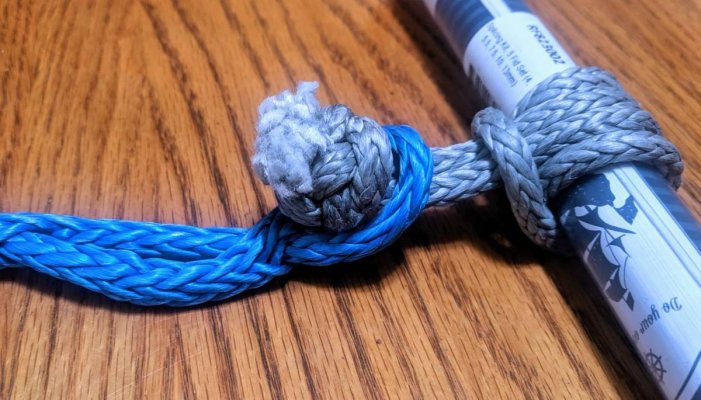
They light blue (gray actually) is 3/16" and is the size of dynema I use for my typical shackles. However, what is pictured is what I used as I was developing this system. The bright blue is 1/4" dynema. The final version of both pieces were made with the 1/4". Much stronger than is needed but the upsizing is is easy and gives a huge safety margin. Keep in mind that these are connecting a bridle that is just 1/2" nylon 3-strand.Outstanding. I didn't get that there were two separate components. Are those both 7/16" Dyneema? The light blue is a simple loop knotted in a monkey fist, and the darker blue is a hybrid "soft shackle eye," right? All home made too, true? I'll get to studying my splicing technique! Thanks Dave.
It is my poor ability to explain, not you.
You know how a soft shackle works, a stopper knot that inserts through a loop.
I use the same idea to connect two dynema pieces. A loop and stopper knot is wrapped around the chain and then the other piece connects the bridle legs to that stopper knot.
Maybe these photos will help. I need to do a better job of putting it together to make it understandable.
I have never found it hard to remove, but there is always a sharp knife.

That is really nice. I do have to go to the bow when raising the anchor to ensure that the anchor doesn't come through the roller upside down. That is an entirely different issue but it does keep me from being able to do the entire operation from the pilothouse. It can get cold, wet, and nasty for sure.Yep, and in 99 times out of a hundred, no issue there. However, in really stinking conditions, I could do the entire up anchor and off move from the protection, need I say comfort, of the downstairs helm - and did so several times in really S**ty conditions. Retrieving the snubber later, once safely under way, and wet weather gear and PFD on...
Twisted,
Does that "shackle" ever come off (fall off) if the whole system goes slack, as in dead calm conditions? I have never used that type, nor seen it first hand.
Forgive me, Dave, as I am a complete soft shackle and bridle using novice. Am I understanding the use of your Dyneema set up correctly? I get the whipping and the added security it creates, and I get the overall strength of Dyneema, and I get the unlikelihood of the soft shackle opening on its own, but I am struggling to understand how the set up connects the two bridle eyes to the anchor rode. Thank you.
It is my poor ability to explain, not you.
You know how a soft shackle works, a stopper knot that inserts through a loop.
I use the same idea to connect two dynema pieces. A loop and stopper knot is wrapped around the chain and then the other piece connects the bridle legs to that stopper knot.
Maybe these photos will help. I need to do a better job of putting it together to make it understandable.
The photo shows the larks head around just one eye but in practice it goes around the two eyes of the bridles. Rather than being wrapped around a chain, the loop and stopper were wrapped around a tube.
If I wasn't lazy I would make a video of how it is all used when anchoring.
View attachment 119388View attachment 119389View attachment 119390View attachment 119392View attachment 119391View attachment 119393
That Mantus looks good to me. Hopefully the elastomeric piece has a long life.
What's the advantage of this over a single shackle coupling the bridle end to a chain link?
Really only two advantages, and those could be questionable. I did it that way in the past.
The first concern for me is the possibility of chafe of the shackle against the galvanized link. Granted, not a huge concern but the galvanized chain could, theoretically, wear through the shackle with enough time.
The second issue is that on my boat, I found it just a bit awkward to run the shackle through a chain link and the two thimbles for the bridle legs. With my current system, once the bridle is set up on the first anchoring, I don’t have to reset it on subsequent nights.
In your situation, where you are using it just as snubber with just the one thimble, running the shackle through the link would be easy. I would just be careful to inspect the shackle. Not really an issue because it takes me all of 10 minutes to make that type of shackle and I always have a few spares laying around.
So, while I think there are advantages, they may be advantages without a difference and may be only applicable to my application.
Amazing that what seems like thin, way undersized material is so ideal for the job.
